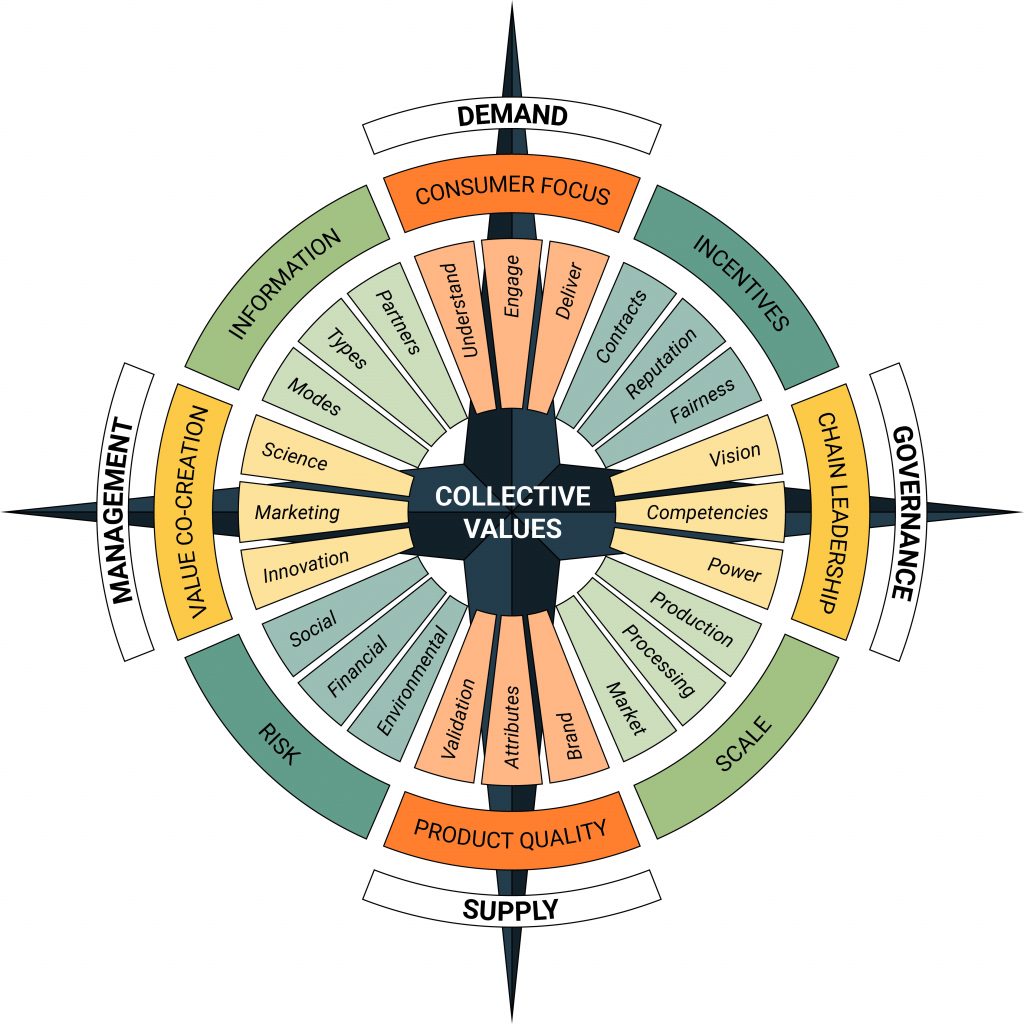Why are some companies better than others at capturing value for their sustainably sourced products? It could be in the way they form relationships with their partners. New research reveals successful exporters share one or more of nine attributes common to strong value chains.
The nine attributes are summarised in the Value Chain Compass – a tool to help managers transform their businesses by improving their value chains. These attributes could provide a template for success. How does your value chain stack up?

- Agree on your collective values
The companies in this study stand for something more than just taste and quality. It could be environmental or social values, a family story or be grounded in a Te Ao Māori worldview. Critically, those values are upheld by all the players in the value chain and provide distinctiveness in the marketplace. The power of the brand story is in its integrity. When one of the players fails to uphold the values the brand suffers.
- Focus on your consumers
Value is created by your consumers – it exists in their mind not in your cost ledger. The successful value chains in this research identify what their consumers value and work back to the producer to meet those expectations. A good example is the work done by Beef+Lamb NZ to identify the $238 million premium that grass-fed beef could achieve.
- Strive for quality
Consumers will pay a premium for quality. This includes taste and texture as well as verified safety, health, social and environmental claims. Companies in this study set high-quality standards across the whole value chain – and stick to them! Manawa Honey is a great example – using its environmental and social backstory and international awards to establish a long-term premium.
- Share the power
In successful value chains, no single player dominates. One may have more power (such as a retailer), one may provide leadership (such as an IP owner like Zespri), and another may be a champion (such as the brand owner). Governance in these chains looks more like a network than a hierarchy and the currency is information.
- Co-create the value
Now that they’re aligned with the consumer need, agreed values and strong relationships, the players collaborate to optimise the chain (remove cost) or create new products (add value). Nagī Tahu's Pounamu is a good example of co-creation. The chain of custody established by Nagī Tahu ensures everyone has a role to play: from the owners of land, to the carver, the retailer and the consumer, who imbues it with meaning
- Share the knowledge
Information sharing among the players is frequent, free-flowing, often face-to-face – kanohi ki te kanohi – and multi-lingual. And the more they talk the more collaborative they become, whether it’s through formal research or informal conversations. Zespri is a great example. At its core is a set of genetics that result in a range of nutritional and environmental benefits (such as being non-GMO). These claims are communicated through chain to the consumer in the form of scientifically verified health and ethical claims.

- Incentivise the right behaviour
These value chains sometimes share costs and rewards to reduce downside risk and incentivise partnerships. And contracts are always aligned to the end result: a happy, well-fed consumer!
- Adjust for scale
Successful chains adapt for scale: high-volume, low-margin products drive for economies of scale. Low-volume, high-value chains protect the artisan perception of a brand. Scale is a key consideration for profitability.
- Manage risk by building resilience
Storms come. Ships get stuck. These value chains create resilience by deploying protective financial instruments and delivery redundancies – all underpinned by strong communication and warmth of relationships, best expressed as whanaungatanga or manaakitanga.
How well does your company manage its value chain? Are there areas you could improve on? Are you leaving value on the table? Try using the Value Chain Compass to audit your own supply chain.
This research was conducted by the Agribusiness and Economics Research Unit and funded by Our Land and Water's Rewarding Sustainable Practices programme. The diagram is copyright of Agribusiness and Economics Research Unit and is licensed under the Creative Commons Attribution 3.0 New Zealand licence









An instruction is not a plan: how to create value in the primary sector
Bill Kaye-Blake, principal economist with NZIER, reflects on 20 years of research into creating greater value in New Zealand’s primary sector. I’ve…